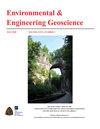Steep Creek Risk Assessment for Pipeline Design : A Case Study From British Columbia, Canada
IF 1
4区 工程技术
Q4 ENGINEERING, ENVIRONMENTAL
引用次数: 1
Abstract
Pipelines in mountainous terrain often cross alluvial fans formed by steep creek processes of debris flows and debris floods and are thus exposed to their associated hazards. The design of new pipeline infrastructure and maintenance of existing pipelines necessitates steep creek risk assessments and appropriate mitigation design. We present methodology for assessing steep creek risk along pipeline routes that evaluates the probability of such processes causing a pipeline loss of containment or disruption in service. The methodology consists of estimating event frequency, scour potential, and the vulnerability of the pipeline to break if impacted by boulders. The approach can be adapted to other landslide geohazards so that different geohazard locations can be evaluated with a common metric. Steep creek process frequency is estimated based on field observations and review of documented events, historical air photo records, and terrain mapping based on LiDAR-generated topography. Scour potential is estimated based on channel morphology, presence of bedrock, and grain size distribution of channel bed material. Vulnerability is estimated based on flow width and velocity and can be modified for different pipe diameters and wall thicknesses. Mitigation options for buried pipelines include those intended to decrease the likelihood of the pipeline being exposed and to increase the resiliency of the pipeline to boulder or organic debris impacts, if exposed. The methodology presented is embedded in risk-informed decision making where pipeline owners and regulators can define probability thresholds to pipeline exposure or rupture, and pipeline designers can demonstrate that proposed mitigation measures achieve these threshold criteria.陡溪管道设计风险评估:以加拿大不列颠哥伦比亚省为例
在山区的管道经常要经过由泥石流和泥石流形成的陡峭溪流过程形成的冲积扇,因此暴露在泥石流和泥石流相关的危险中。新管道基础设施的设计和现有管道的维护需要陡溪风险评估和适当的缓解设计。我们提出了沿管道路线评估陡溪风险的方法,该方法评估了此类过程导致管道泄漏或服务中断的可能性。该方法包括估计事件频率、冲刷潜力以及管道在受到巨石影响时破裂的脆弱性。该方法可以适用于其他滑坡地质灾害,从而可以用一个共同的度量来评估不同的地质灾害地点。陡溪过程的频率是根据现场观察和对记录事件的回顾、历史航空照片记录和基于激光雷达生成地形的地形测绘来估计的。冲刷势是根据河道形态、基岩的存在和河床物质的粒度分布来估计的。脆弱性是根据流宽和流速来估计的,并且可以根据不同的管径和壁厚进行调整。埋地管道的缓解方案包括那些旨在减少管道暴露的可能性和增加管道在暴露时对巨石或有机碎屑冲击的恢复能力的方案。所提出的方法嵌入在风险知情决策中,管道所有者和监管机构可以定义管道暴露或破裂的概率阈值,管道设计人员可以证明拟议的缓解措施达到这些阈值标准。
本文章由计算机程序翻译,如有差异,请以英文原文为准。
求助全文
约1分钟内获得全文
求助全文
来源期刊

Environmental & Engineering Geoscience
地学-地球科学综合
CiteScore
2.10
自引率
0.00%
发文量
25
审稿时长
>12 weeks
期刊介绍:
The Environmental & Engineering Geoscience Journal publishes peer-reviewed manuscripts that address issues relating to the interaction of people with hydrologic and geologic systems. Theoretical and applied contributions are appropriate, and the primary criteria for acceptance are scientific and technical merit.
 求助内容:
求助内容: 应助结果提醒方式:
应助结果提醒方式:


